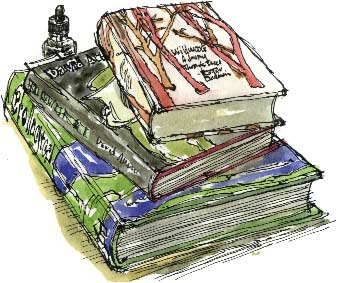 HERE'S
MY current crop of reading:
HERE'S
MY current crop of reading: HERE'S
MY current crop of reading:
HERE'S
MY current crop of reading:
Wildwood; A Journey Through Trees by the late Roger Deakin. I made the mistake of trying to read this 400 page book when we were having so much done in the house and I was putting a lot of effort into my own book, so I came to it exhausted for about ten minutes each night before dropping off to sleep with the result that his journey didn't flow for me. I kept thinking 'Are we still in Kazakhstan studying the walnut harvest?!'
As an illustrator, I have a bit of a problem with such literary books; they don't have illustrations (except for chapter headings, that is). We have Deakin's eloquent word pictures of, for example, his artist friends cobbling together constructions out of driftwood and topiary but we're never allowed to see the results.
My favourite section was his affectionate account of his school field trips in the late 1950s or early 1960s to a quiet corner of the New Forest. I would have liked more of this, especially if he'd included one or two pages from 'The Tome', the loose-leaf binder in which the group recorded their observations and adventures.
The literary approach to natural history sets great store on words - for instance that a hedge-layer's bendy branch is called a 'plancher' in the Midlands, but a 'pleacher' in Suffolk (I've probably got that wrong). Deakin loves words and their origins and, in a similar way, he loves the traditional hand-tools associated with hedging and woodcraft so whenever possible he would buy them at farm sales, restore them and use them.
Because of this approach, I felt that I came away from this book knowing more about what various people think, feel and believe about trees and that I didn't learn as much as I hoped I might about the trees themselves . . . which brings me to the next book in my pile of reading:
The Private Life of Plants by David Attenborough has plenty of colour photographs, and is written with such clarity that I never find myself going back over a paragraph wondering if I've just missed the point. As in other books tied to films in the Life on Earth series, Attenborough takes steps to avoid the fascinating by-ways of nomenclature, which would feature in a more literary work. He sees them as a distraction from the story he is telling of the plants themselves. If you should need the scientific name, he includes it in the index.
I like the way he gives a common plant like bramble centre stage in the book and in the television series, rather than always going for the 'tallest', 'oldest' or most exotic of plants. I'm re-reading this because, in common with other bits and pieces in the the house, our old video recorder packed recently. We replaced it with a VHS/DVD/Freeview/Digital/Analogue recorder and I soon spotted that some of the classic series I've saved on video are currently being repeated during the day on the UKTV History Freeview channel, so I've been taking the chance to replace my bleary video-tapes with crisp new DVD recordings.
It's a good opportunity to read the book and watch the shows again.
My final book, Geologica, by Dr Robert Coenraads looks as if it should be tied to a spectacular television geology series but isn't. It's a good example of how books can still hold there own in the days of High Definition panoramic television. In addition to the aerial views, satellite images, dramatic geological events and stunning scenery, there's an informative and - as far as I'm in a position to judge - authorative text.
One problem; it's a bit too big to comfortably read in bed!